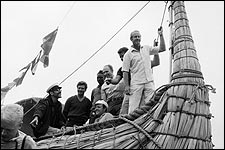FIVE-ELEVEN, BLOND, PERPETUALLY TAN, and full of scholarly exuberance, Norwegian explorer Thor Heyerdahl was a charismatic, controversial figure, and when he died of a brain tumor on April 18 at 87, a chapter in the history of adventure ended. Heyerdahl launched a revolution in experimental archaeology, a discipline that aims to learn about ancient cultures by reconstructing their technologies and retracing their footsteps. In 1947, Heyerdahl, then 32, was determined to prove that ancient South Americans could have made contact with Polynesia, so he sailed from Peru to the Pacific island of Raroia for 101 days on a 45-foot balsa-wood raft he dubbed Kon-Tiki.
 Heyerdahl in 1969, at the launch of his papyrus-reed raft RA in Morocco
Heyerdahl in 1969, at the launch of his papyrus-reed raft RA in Morocco
Though in recent years some of Heyerdahl’s theories have been resurrected by anthropologists, his subversive ideas initially earned him a reputation among scientists as a crackpot. But Thor the Unflappable continued launching one dangerous experiment after another. In 1969, he tried sailing across the Atlantic in a papyrus-reed boat he named the Ra. The boat disintegrated, but the following year Ra II completed the journey in 57 days. In 1978, he attempted to link ancient Egyptian, Mesopotamian, and Indus Valley cultures by sailing down the Tigris River to the Red Sea via Pakistan aboard a reed vessel called Tigris. In his later years, Heyerdahl began concentrating on prehistoric sites on Easter Island and step pyramids on the Canary Islands.
Over the years, adventurers such a famed polar explorer Sir Ranulph Fiennes have been inspired by Heyerdahl’s bold exploits. “I don’t think I’ve had an adventure where Thor Heyerdahl has not come up in conversation or in mind,” says 30-year-old Canadian Colin Angus, who has completed pioneering source-to-sea descents on the Amazon and Yenisey rivers. “Heyerdahl showed us that there are unique and fascinating adventures to be had that have nothing to do with being first or fastest.”


